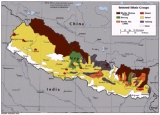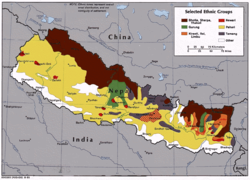
Tamang language
Encyclopedia

Nepal
Nepal , officially the Federal Democratic Republic of Nepal, is a landlocked sovereign state located in South Asia. It is located in the Himalayas and bordered to the north by the People's Republic of China, and to the south, east, and west by the Republic of India...
and Sikkim
Sikkim
Sikkim is a landlocked Indian state nestled in the Himalayan mountains...
. It comprises Eastern Tamang, Northwestern Tamang, Southwestern Tamang, Eastern Gorkha Tamang, and Western Tamang. Lexical similarity between Eastern Tamang (which is regarded as the most prominent) and other Tamang languages varies between 81% to 63%; lexical similarity
Lexical similarity
In linguistics, lexical similarity is a measure of the degree to which the word sets of two given languages are similar. A lexical similarity of 1 would mean a total overlap between vocabularies, whereas 0 means there are no common words....
between Spanish
Spanish language
Spanish , also known as Castilian , is a Romance language in the Ibero-Romance group that evolved from several languages and dialects in central-northern Iberia around the 9th century and gradually spread with the expansion of the Kingdom of Castile into central and southern Iberia during the...
and Portuguese
Portuguese language
Portuguese is a Romance language that arose in the medieval Kingdom of Galicia, nowadays Galicia and Northern Portugal. The southern part of the Kingdom of Galicia became independent as the County of Portugal in 1095...
, for instance, is estimated at 89%.
Dialects
The Tamang language has further been subdivided into the following dialects-- Eastern Tamang: 759,257 in Nepal (2000 WCD). Population total all countries: 773,257;
- Western Tamang: 322,598 (2000 WCD);
- Southwestern Tamang: 109,051 (1991 census);
- Northwestern Tamang: 55,000 (1991 census);
- Eastern Gorkha Tamang: 3,977 (2000 WCD).
Tamang language is the largest Tibeto-Burman language in Nepal.
Grammar
Some grammatical features of Tamang languages are- A canonical word order of SOV
- Use of postpositions;
- The genitives follow nounNounIn linguistics, a noun is a member of a large, open lexical category whose members can occur as the main word in the subject of a clause, the object of a verb, or the object of a preposition .Lexical categories are defined in terms of how their members combine with other kinds of...
s; - questionQuestionA question may be either a linguistic expression used to make a request for information, or else the request itself made by such an expression. This information may be provided with an answer....
word medial; - It is ergativeErgativeThe term ergative is used in grammar in three different meanings:* Ergative case* Ergative-absolutive language* Ergative verb...
language; - CV, CVC, CCV, V, CCVC;
Phonetically Tamang languages are tonal.
Writing system
Tamang languages use Tam-Yig which is similar to Tibetan scriptTibetan script
The Tibetan alphabet is an abugida of Indic origin used to write the Tibetan language as well as the Dzongkha language, Denzongkha, Ladakhi language and sometimes the Balti language. The printed form of the alphabet is called uchen script while the hand-written cursive form used in everyday...
s and Devanāgarī
Devanagari
Devanagari |deva]]" and "nāgarī" ), also called Nagari , is an abugida alphabet of India and Nepal...
. In many situations, however, Tamang is written in Devanāgarī
Devanagari
Devanagari |deva]]" and "nāgarī" ), also called Nagari , is an abugida alphabet of India and Nepal...
proper.
See also
- TamangTamangThe Tamangs are the ancient and original inhabitants of the mountains and plains of the Himalayan regions of Nepal and India. Their ancient capital being Yambu - modern day Kathmandu. They have their own distinct culture, language and religion. Their ancestral domain is popularly known as...
(ethnic group) - GurungGurungThe Gurung people, also called Tamu, are an ethnic group that migrated from Mongolia in the 6th century to the central region of Nepal. Gurungs, like other east Asian featured peoples of Nepal such as Sherpa, Tamang, Thakali, Magar, Manaaggi, Mustaaggi, and Walunggi, are the indigenous people of...
(ethnic group) - Languages of NepalLanguages of NepalThere are some 120 native languages of Nepal, belonging to the Indo-Aryan, Sino-Tibetan, Austro-Asiatic and Dravidian language families.The official language of Nepal is Nepali , formerly called Khaskura then Gorkhali. The 2001 census counted 11 million native speakers in Nepal and it is spoken as...
- Languages of BhutanLanguages of BhutanThere are over nineteen languages of Bhutan, all members of the Tibeto-Burman language family, except for Nepali which is Indo-European. Dzongkha, the national language, is the only language with a native literary tradition in Bhutan, though Lepcha and Nepali are literary languages in other countries...

